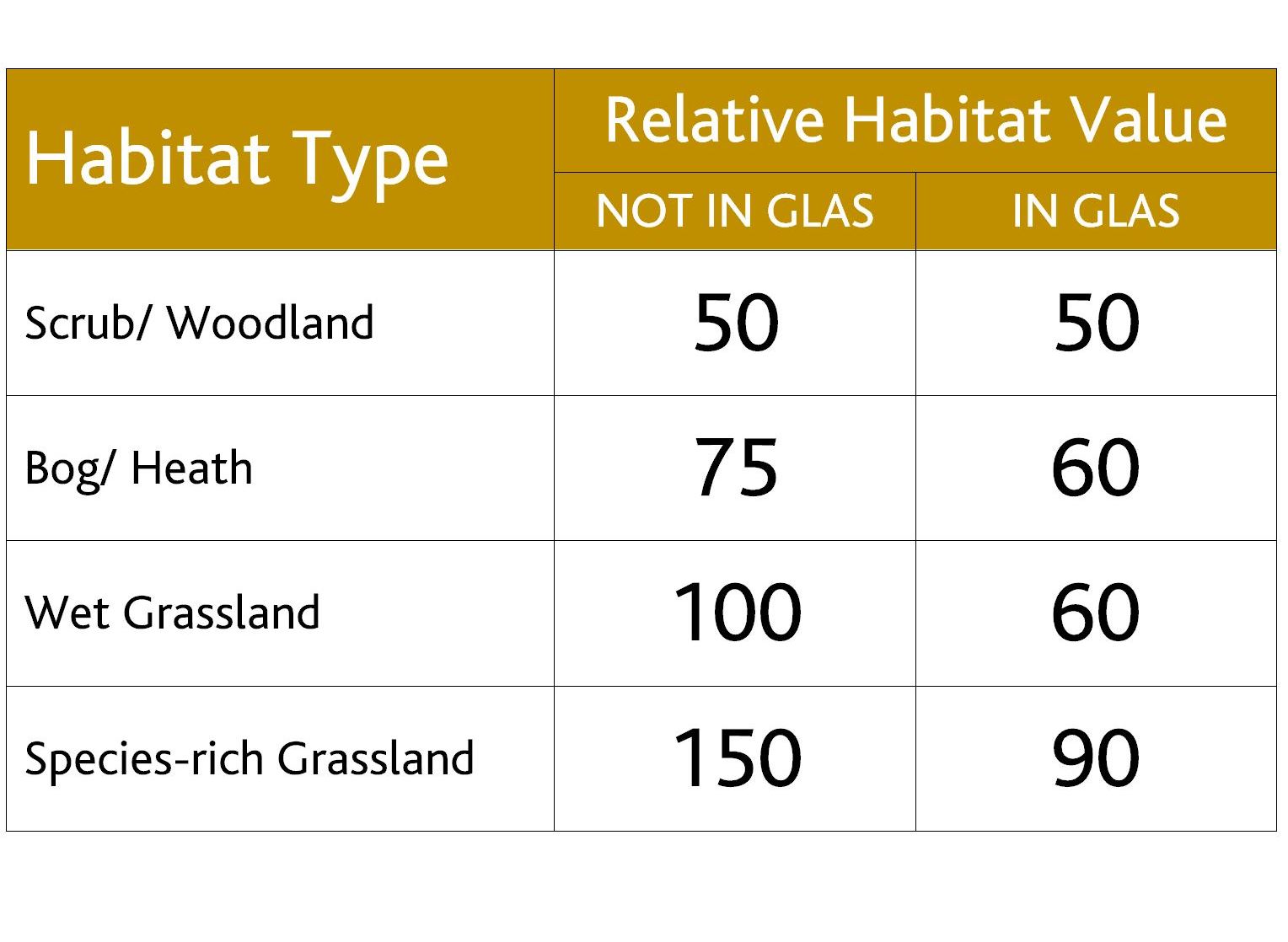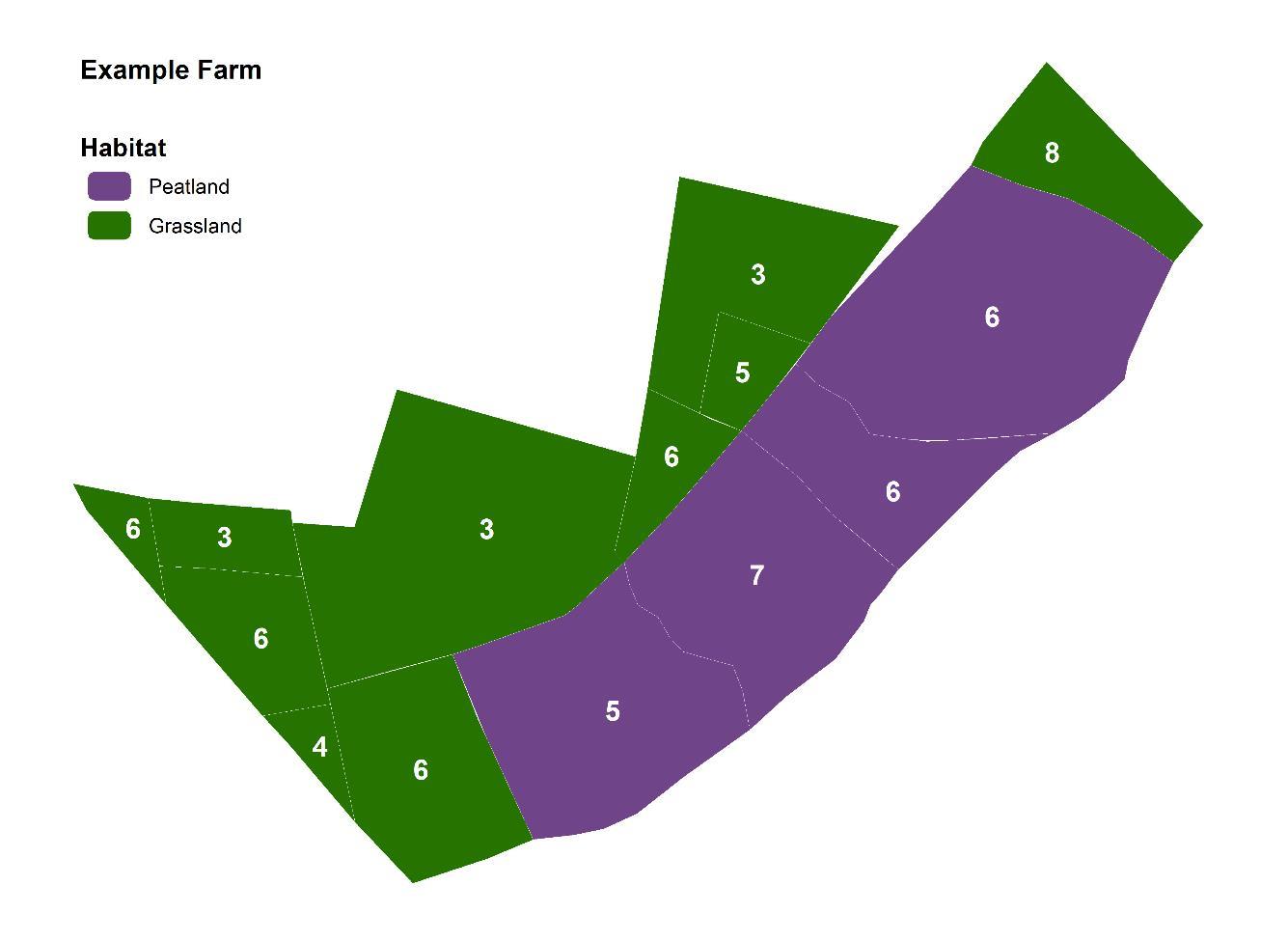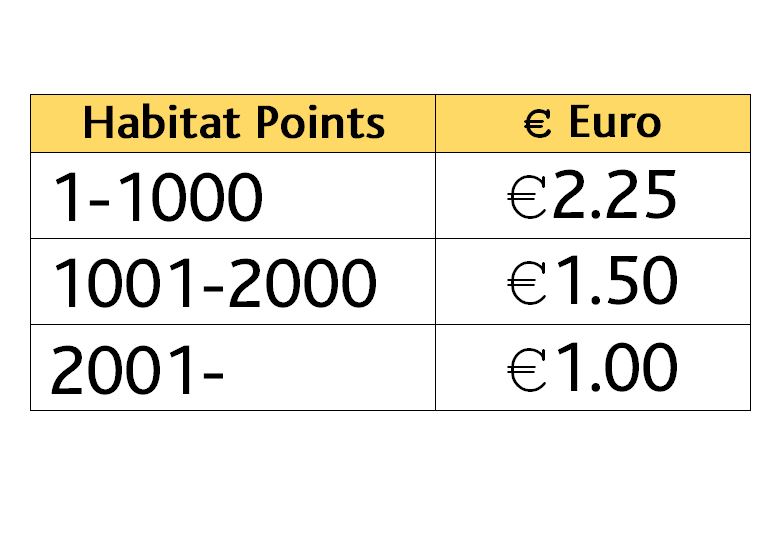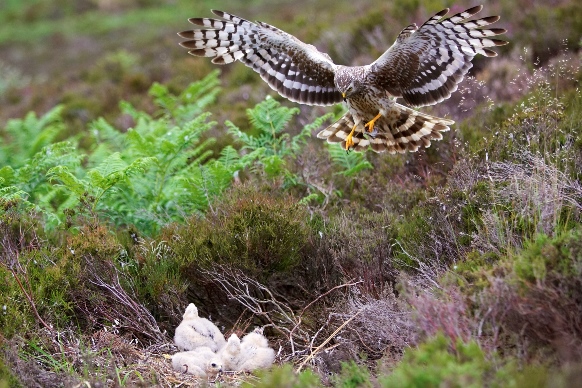Innovation Partnerships (EIPs) are a new approach to EU research and innovation. EIPs are challenge-driven, focusing on societal benefits and a rapid modernisation of the associated sectors and markets. The Hen Harrier Project is funded through EIP-AGRI (https://ec.europa.eu/eip/agriculture/).

This is based on the available Hen Harrier foraging and nesting resource and a relative habitat value. The relative habitat value varies depending on the habitat type and whether the participant is in GLAS or not. These values are shown in the table (left):
The Potential Habitat Points are the maximum points that a field can attain. If a field has a maximum potential score of 100 and receives a score of 5 out of 10 then the actual points received will be 100* (5/10)= 50 points.

The relative peatland value is 60 and the relative grassland value is 60. The peatland and grassland habitats with their Potential Habitat Points in this example are displayed in the figure (right).
The total Potential Habitat Points for this farm is 1,380.

The field scores in this example are displayed in the figure (left). This is the calculated as follows-
Earned points per field = Potential Habitat Points x(Field Score/10).
Fields that score 3 or less receive 0 points.
For this example farm the total Actual Points is 612.

612 points x €2.25 = €1,377
If all scores increased by 1 in year 2 this farm would receive 869 points.
869 points *€2.25 = €1,955
If all fields scored 10 this farm would receive a maximum of 1,380 points: 1,000 points x €2.25 + 380 points x €1.50 = €2,820

Participant farmers can avail of two types of Hen Harrier Payment. The available funds will be split evenly between the two types of payment. These are i) An SPA Level Payment and ii) a Local Nest or Winter Roost Payment. The participating farmer may qualify for one or both payments. The SPA Level Payment rewards participating farmers whose SPA continues to support a stable or increasing Hen Harrier population. If SPA level goals are achieved, then all participating farmers with a field scoring 6 or higher in that SPA will qualify for this dividend. Participants qualify for the Local Nest or Winter Roost Payment based on having at least 1 field with a field score of 6 or higher within a defined distance of a breeding site/ winter roost site or a successful nest site.
A farm must have at least one field with a score of 6 or greater to qualify. The example farm used above could potentially receive upto €1,000 in year 1. The budget for 2018 is €200,000 divided equally between the local nest/ local roost component and the SPA component.
The small Hen Harrier population in Slieve Beagh SPA has undergone a slight decline in the last 10 years, however this population is part of a larger cross-border colony occurring within the Slieve Beagh - Mullaghfad - Lisnaskea SPA designation in Northern Ireland and there has been some interchange of breeding pairs. Repression of breeding numbers and low productivity have been caused primarily by degradation of habitat through extensive, mechanised turf-cutting, uncontrolled illegal burning, and higher predation pressure from adjacent forested areas. The SPA Goal for Slieve Beagh in 2018 is set at 3 confirmed nesting pairs of Hen Harrier.
The large continuous open areas of heath/bog in Slieve Bloom Mountains SPA support a stable/slightly increasing population of breeding Hen Harrier. Most pairs in this region are recorded nesting in moorland. The Slieve Blooms has the highest fledging rate of all SPAs. Threats and pressures on this population are largely linked to forest and plantation management activities, habitat fragmentation and associated higher predation pressure. Forest plantation fringes the entire plateau and accounts for 61% of the land cover within the SPA. The SPA Goal for the Slieve Blooms in 2018 is set at 10 confirmed nesting pairs of Hen Harrier.
The Hen Harrier population in the Mullaghanish to Musheramore Mountains SPA at designation was 5 breeding pairs, however has undergone serious decline in the last 10 years. No pairs were recorded breeding in the SPA in 2014 and in recent years the population is between 1 and 2 pairs. Threats and pressures on the population include uncontrolled burning, forestry activities, wind farm development, and disturbance through peat extraction. Persecution may also be an issue. The SPA Goal for the Mullaghanish to Musheramore Mountains SPA in 2018 is set at 1 confirmed nesting pair of Hen Harrier.
The breeding Hen Harrier population in the Slievefelim to Silvermines Mountains SPA is stable and increasing. Hen Harrier nest in a range of habitats (heath/scrub/pre-thicket forest) in the SPA, however most recent monitoring data shows the majority of pairs select heather for nesting. Threats and pressures in this SPA are similar to other areas, including forest and plantation management activities, habitat loss through changing land use, uncontrolled burning, disturbance etc. The SPA Goal for the Slievefelim to Silvermines Mountains SPA in 2018 is set at 4 confirmed nesting pairs of Hen Harrier.
The breeding Hen Harrier population in the Slieve Aughty Mountains SPA has almost halved from 27 territorial pairs in the last 10 years. Confirmed breeding pairs in the SPA predominantly select 2nd rotation prethicket forest for nesting. Recent monitoring data show a subsequent high nest failure rate and very low numbers of fledged young per confirmed pair. Most frequently recorded pressures are habitat loss/disturbance from forest and plantation management activities, new tracks/paths and uncontrolled burning. The SPA Goal for the Slieve Aughty Mountains SPA in 2018 is set at 8 confirmed nesting pairs of Hen Harrier.
The Stack’s to Mullaghareirk Mountains SPA supports the highest proportion of breeding Hen Harrier within the SPA network. The population is decreasing, having declined by a third in the last ten years. This decline and change in patterns of occupancy by territorial pairs is linked to decreasing habitat availibility and suitablitiy across the SPA, however where pairs are successful they tend to be productive. Hen Harrier nest in a range of habitats (heath/scrub/pre-thicket forest) in the SPA. Main threats and pressures on the Hen Harrier population in this SPA are largely forest and plantation management activities and wind energy production. Persecution is also a concern. The SPA Goal for the Stack’s to Mullaghareirk Mountains SPA in 2018 is set at 23 confirmed nesting pairs of Hen Harrier.